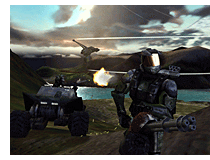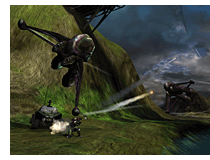
By Tuncer Deniz
Jason Jones, for the most part , shuns the spotlight. Even though Jones has created classics such as Marathon and Myth, his name is almost never mentioned with the likes of Carmack, Meier, and Sweeney. That may all change now with Halo, the new game from Bungie unveiled at Macworld Expo this past July.
Since then the game has caused quite a stir. Previews have been popping up all over the net and the media is in a frenzy to get more info out of Bungie. Yet there's no sign of Jones anywhere. Where is he? Why haven't we seen any interviews with him? The answer is an easy one, Jones is busy working on what he loves, creating games. Interviews and the such are not his priority right now, finishing the games is.
Having worked at Bungie for three years, I've seen Jones' work first hand. Determined and brilliant, Jones' passion in life is working with his team. His dedication to his project and the company he help found are unparalleled.
Getting this interview was extremely difficult. But thanks to my former affiliation with Bungie (and a little begging), IMG was able to secure this exclusive interview.
IMG: Halo has been in development for over a year and a half now. Can you talk about Halo's beginnings as a strategy game and how it transitioned to a 3rd person action game?
JJ: There's an important distinction to make there - Halo didn't begin as a strategy game but the engine it uses started out that way. The engine Halo uses began as a next-generation Myth terrain engine, with polygonal units. After playing around with it for a while, putting it through many iterations, it became clear that focusing the action on a single character would be a more compelling use of this world than a strategy game design. It didn't become Halo until long after we focused on making it a third-person action game.
 IMG: Halo seems to be quite a ways away from being finished. Why did Bungie choose to unveil it at Macworld Expo New York?
IMG: Halo seems to be quite a ways away from being finished. Why did Bungie choose to unveil it at Macworld Expo New York?
JJ: Bungie games are generally developed in three stages: first we make the environment and the engine, then the multiplayer, where we learn to balance units against each other, sort of work out the parameters of each different unit, then the single-player game as the last, perhaps the most challenging, step. That was how the first Marathon was developed, and Myth, and that's what we're doing on Halo. So, we're about done with the first stage at this point, roughly 1/3 done.
Why choose Macworld?
Steve Jobs' keynote address is a great platform for getting news out to a very large number of people, particularly to mainstream press folks who don't usually spend a lot of time covering games. Now that he has done the first public showing of Quake III and Halo, Jobs has quite a roll going with major game announcements.
IMG: Can you talk a little bit more about Halo's whiz-bang features such as volumetric lighting and per-pixel reflections. Can you explain these and how are these used in the Halo world?
JJ: One of the reasons it looks so good is multipass texturing. Every major object in the Halo world has at least two texture maps, and many have several more. For example, the alien hover vehicle seen in the keynote trailer has four maps, a base color map, specular map for lighting effects, a "dirt" map for the scuffs, burns and pitting that objects in a real battlefield might have, and a per-pixel reflection map for varying levels of reflectivity from shiny objects.
IMG: There's been talk of deformable terrain in Halo. Can you explain further? Were the dust and small rocks from the demo a part of this?
JJ: The deformable terrain referred to in the release is the terrain mesh. In Myth there is a terrain mesh but it's static - doesn't change in response to events in the game world. In Halo, if there's a huge explosion, or an orbital strike on a piece of flat ground, it will leave a hole that is a permanent part of the landscape. The rocks and dust are particle systems, like the weather in Myth. Nature is full of particle systems, and if you want to create a natural environment, you gotta have particle systems all over the place.
IMG: How would you classify Halo? Some have called it a mix between Tribes and Myth 2. Is the focus on strategy or action?
JJ: Hmm... that's a fairly misleading characterization. It's third-person action and takes place in a fully 3D world, but that's as far as the parallels go. There are tactical choices involved in the way you fight the aliens, but genre-wise, it's an action game.
IMG: One of Halo's more impressive features is going to be the lack on levels. Can you describe what the single-player gameplay will be like?
JJ: Probably the most unique aspect to the game is the single, continuous world, with seamless indoor and outdoor environments. There won't be any occasions when the gameplay stops and a dialog box pops up to say "you have now finished X level, now you must go do Y mission." Instead, the player will have a great deal of discretion as to where they go in this world and how they choose to wage war against the aliens.
IMG: Any particular reason for the Marathon logo, or is it just for kicks? Is Halo somehow tied to and/or an extension of the Marathon series?
JJ: I'll say this: Observant fans of our games will note that certain themes tend to run through our games. For example, the sword Durandal (from the "Song of Roland") first appears in Minotaur as a magic sword and goes on to become a central character in Marathon. There are many other examples of common themes running through our games.
 IMG: What is your target hardware configuration for Mac and PC? Not the minimum system, but what would be adequate for the full game experience? Also, what kind of 3D API's will Halo support?
IMG: What is your target hardware configuration for Mac and PC? Not the minimum system, but what would be adequate for the full game experience? Also, what kind of 3D API's will Halo support?
JJ: It's too early to say what the target system is going to be. What we know now is that it will require a 3D card, it will support the major APIs on both platforms, and we'll incorporate options to make the game fun to play on lower-end systems.
IMG: The vehicle physics shown during the Macworld demo are remarkable, even by driving sim standards. Is there a unified set of physics that every object responds to? In other words, do all objects have mass and inertia?
JJ: Yes. Myth built substantially on Marathon's physics model, and Halo's model is considerably more elaborate than Myth's. For example it's no problem for a tank to push a jeep over a cliff, but just try doing the reverse.
IMG: You've said several times that the emphasis is on cooperative teamplay rather than simple deathmatches. How will teammates communicate? Will the battles be against enemy AI, enemy teams, or both? Will you be able to have bots on your own team? Will there be a Bungie.net style game finder?
JJ: We're just now starting work on multiplayer and it's too early to go into specifics about how the net game will work.
IMG: Will Halo be extensible, via plugins (like Myth and Marathon)? Do you foresee user-created levels at some point?
JJ: We fully expect it will be extensible - what form that will take is undetermined. As you know there are active map-making communities for both Marathon and Myth, and it's safe to expect this will be true for Halo.
IMG: Are you developing Halo with your own tools, or using existing commercial products like the Oni team?
JJ: Well, the Oni team is also using their own tools, with the exception of a CAD program that allows them to design environments in the way that the two level designers were trained to do as architects. But yes, the tools being used by Halo were created by the team.
IMG: When do you expect Halo to be released? Is first-half 2000 realistic?
JJ: This the product of an experienced team, with many ambitious, successful game titles under their belts. If we say it's realistic, it's realistic. Having said that, we're an independent developer/publisher, without shareholders to appease, only customers. As such, neither development nor publishing are interested in releasing a game before it is done.
IMG: Bungie has had a long-standing relationship with Apple. How do you think Apple is doing as far as hardware and software goes? In what areas is Apple lacking?
JJ: They're not just talking about supporting game development better, they're doing concrete things, like putting powerful 3D cards in their new machines, bundling games on them and showcasing games in their keynote addresses. The decision to go with OpenGL was great. There are some things that still need to be done, like support for 3D audio, but they're definitely on the right track.
![]()
Subscribe to Inside Mac Games
Inside Mac Games is the only magazine solely devoted to Macintosh entertainment, covering the latest news & information on Macintosh game software and hardware. Each CD-ROM issue of IMG is packed with exclusive previews of the latest soon-to-be released games and in-depth game reviews plus demos, shareware, and much more!
![]()